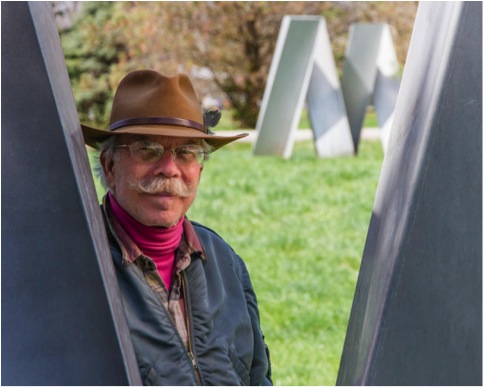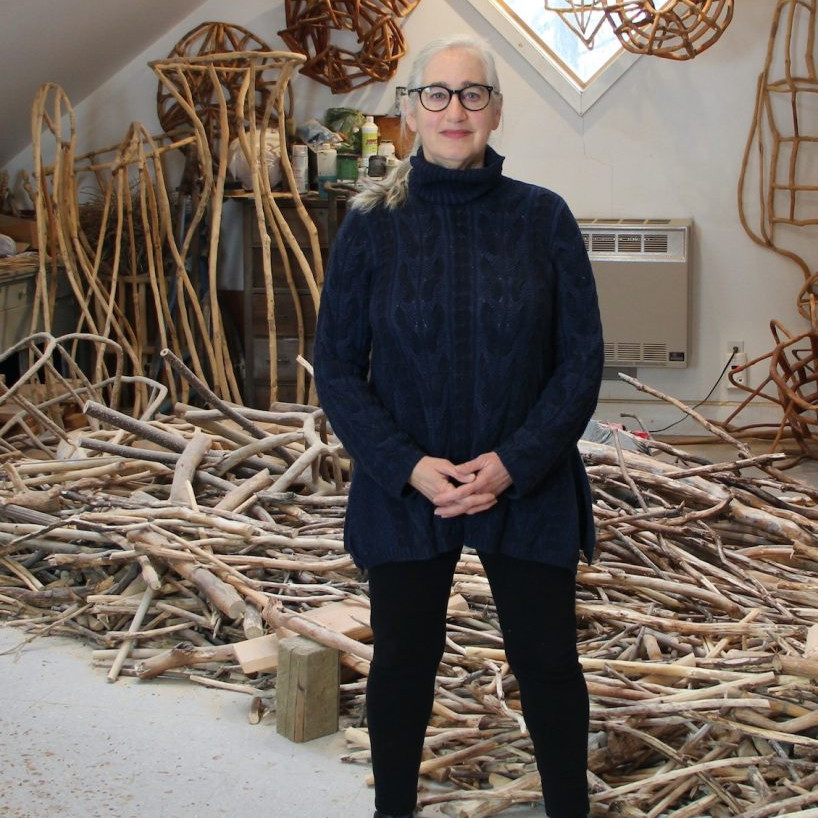Jon Barlow Hudson Sculptor - Ohio, USA
Can you discuss your thoughts on where and with whom the “Behind the Scenes’ drawings etc. for a public art piece are stored for prosperity?
This is a very broad question and one I cannot really answer as I am sure that of the hundreds of public art entities deal with such things in different ways. Sometimes they might want the drawings or whatever that lead up to their piece to be part of their documentation of a project and others might not care at all. An unusual example is that I not long ago donated all my structural engineering papers and others to the Queensland State Library in Brisbane relative to my two major sculpture projects for the World Expo 1988, held in Brisbane. The Minister for the Arts Ian Walker received the donation into the library. Following that I offered the stainless steel sectional maquettes of the 100 foot high sculpture PARADIGM, to them also, to fill out their Expo collection. Often such items and donation might simply go the relevant public art committee.
Discuss your thoughts on world exposure to your sculptures career?
I attribute my work as an artist to having grown up traveling and living around the world from a very early age. All that I have seen, experienced and done, overseas in particular, has made me the unique person and the artist that I am: without which I would be a totally different person. The shape and meaning of my sculptures is the fruit of this experience. My first large–scale public sculpture project overseas was the commission of two very large scale stainless steel sculptures for World Expo 1988 in Brisbane, Australia. Following that project, I continued to receive commissions for projects in, 27 different countries. If I could say that one project led specifically to another, I would. I can only surmise that each and all of these overseas projects and international and intercultural experiences has contributed in one way or another to ‘My life, my sculpture and to my career’. Back in ’86 when I first made contact with Expo, to my perception there was not much attention to overseas projects by national artists. Given my life experience, it made eminent sense to focus outward and pursue overseas projects since my sculpture and my aesthetic sensibility is based upon universals and the timelessness of art and creativity, I was charged with expanding around the world with my sculpture. This has in turn immeasurably enriched my life not just by the experiences, but through the friendships and personal contacts that I have encountered throughout these overseas adventures. I probably know more international artists and friends than I do State—side, all of whom have made some contribution to my life and career.
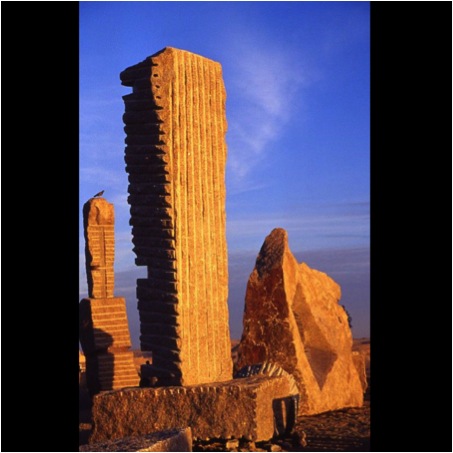
ASWAN SYNCHRONICITY & TS’UNG TUBES
2001, 2002, Aswan granite. Aswan International Sculpture Park, Aswan, Egypt
How important was your time with Charles Ginnever in Vermont to your later professional life as a sculptor?
I greatly value the year with Ginnever both for his friendship and for the experience of being around a professional “New York” sculptor whose friends and colleagues were/are DeSuvero, Chamberlin, Kaprow, Forakis, Downsberry, Weiner and others. I helped make his large scale steel sculptures and helped with his exhibits, such as with the Louis Kahn maquettes and his sculpture models. It provided a creative, adventurous environment in which to explore and develop my own sculptural ideas.
Towards the end of the year, his friends Allan Kaprow and Paul Brach, among others, were helping form the California Institute of the Arts in LA, which led to my attending Cal Arts for its first two years, resulting in my BFA and MFA in 1972. Had I stayed in my home town working in my studio, or returned to Germany or elsewhere, my life would have been totally different. My time with Ginnever let to Cal Arts, which led to the 2 years working at a gold mine in northern California, then to New Mexico and on. He lives in my mind as a quintessential American sculptor, making wonderful sculpture, on a par with his contemporaries.
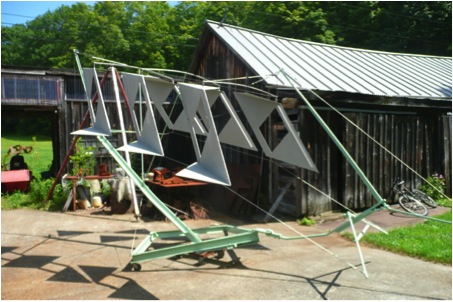
DANTE’S RIG, Chuck Ginnever
Aluminium, steel & cables. About 3 m. hi.X 4 m. L. x 2 m. wide. c 1966 aprox.
Discuss how your art has been influenced by your travels?
My first five years were on the plains of Wyoming. The American First Nations peoples say that these years are a time that is very important in one’s formation, so they ask about your upbringing during these years. Following this we moved east, then about a year later we continued on east to the deserts of Saudi Arabia for three years: still formative years. My world travels began then and continue today. That early experience in the Mid East and other places between here and there, exposure to ancient stone architectures and distinctive, impressive natural environments, have been a constant inspiration in my being, my relation to the natural environment of the world, to previous cultures and creative products of both ancient and contemporary times—and of the sculpture I make today. As a kid, to climb around Baalbek, Petra, Jerash, Rome, Machu Pichu, puts one in touch with earlier peoples—one receives a communication from them. While I began my public art “career” working with stainless steel, a rather contemporary material, I tend to prefer working with stone: both as a way to work with nature, but also to do as the makers of Baalbek did, and speak to peoples down thru time into the future.
You have a strong background in the fine arts. Discuss your thoughts on how an academic background supports an artist
Creativity takes as many forms as there are artists. Each artist must follow and create their own path. For some it may be as an independent, “folk” or “non-academic” artist, as an artist nevertheless. Such folks often have a strong sense of discipline and vision, so are easily at work rather than not. My lot was to grow up going to school, then on to college, transferring to the Dayton Art Institute, then Stuttgart Art Academy, Ginnever’s farm studio, finally Cal Arts, eventually teaching art at university. My trajectory was academically based. It provided me with a broad education and experience in making art in a wide variety of media and a broad study of the history of the various arts. My intention was to teach art, and for that the academic foundation is necessary. Interest changed and I focused on making sculpture as an independent artist. However, I consider that a broad education is important in teaching critical thinking, an open and inquiring mind and providing useful training and discipline for whatever creative endeavour one might choose.
Can you discuss the commission of ‘FIREWALL?
A state-wide competition was set up calling for a firefighter memorial for this country region. My past work got me chosen to make a proposal, which was the one selected.
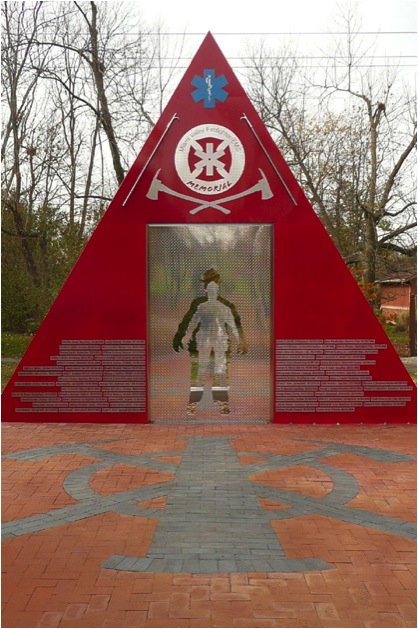
FIREWALL
c 2010, Steel powder coated, stainless steel, aluminium, brick, 5 meters high x 15 m. x 15m. Miami Valley Firefighter/EMS Memorial
FIREWALL was commissioned to be a memorial for fallen firefighters and emergency medical service people. I wanted to create something that was an obvious reference to firefighting and that was different from other such memorials. I also wanted to create something that was an outdoor environmental work that created a special and sacred space for memorial services to take place. The triangular shapes were arrived at in order to symbolize fires, and of course the colour red. There are numerous firefighting symbols within the work, along with a silhouette of a firefighter. This was inspired by a Jain icon of the Buddha—the figure being empty space. The brick precinct within which the three triangles are installed includes the firefighting symbol of the axe and hose nozzle.
The memorial is installed in a natural park setting with a path made of cobble-stones from an old fire station. As one approaches the memorial down the pathway, one will see the three fires/triangles, then the silhouette of the fallen firefighter cut out in the bright aluminium diamond–plate in the centre of the large triangle—which material is found in the middle of many fire trucks. Then as one enters the precinct, one is surrounded by the three fires—much like the experience of the firefighter performing their duties.
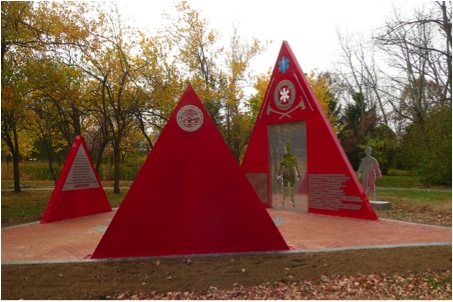
On both sides of the silhouette are attached the names of currently 68 fallen firefighters & EMS personnel. The sculpture is 5 m. hi. The largest triangle and the three of them are installed on a brick precinct 15 m. on a side. The triangles are made of welded steel powder-coated red, with parts in aluminium, stainless steel and brass. It is installed in Stubbs Memorial Park, Centerville, OH, USA, 2010.
‘Double Helix’ is a mathematical piece and it is also viewed daily by professional mathematicians. Can you discuss this?
HELIX was commissioned for the Wright State University Diggs Life Science Laboratory in an Ohio state percent for art project 2008. Their theme was the bio-sciences, as well as mathematics and geometry, given that the math building was next door and some of their funds were involved. After much thought and research into these disciplines, I arrived at the idea of a double helix constructed of dodecahedra, which are Platonic solids constructed of 12 pentagonal shapes. They are welded together, with the welds ground down and away, so that the geometry remains clean and clear. They are assembled in the configuration of two helix which intertwine but do not touch. They are large enough for people to walk through them and sit on them. This project was designed in relation to the environment of the bioscience building courtyard and other surrounding buildings.
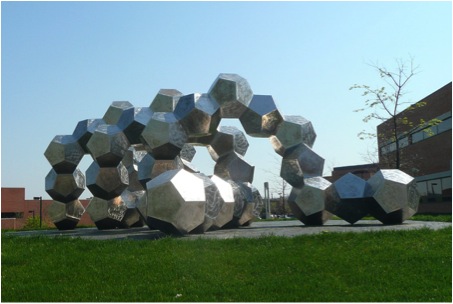
The sculpture is constructed of welded stainless steel with sanded surfaces, each pentagon being unique and is installed on a berm of grass covered earth with a black brick surface just under the sculpture. It is 2.6m. hi. X 2.6m. w. x 8 m. Long.
As the viewer walks around HELIX they will see how the two helixes intertwine and rotate in a flow of geometric form. The many different surfaces reflect the light in many different angles so the light and colour is multifaceted. Most double helix sculptures look more like the DNA molecular structure, whereas this one is more abstract, the two helixes are not connected together and the use of dodecahedra is not normally associated with DNA double helixes. As the viewer walks through the canter of HELIX they will be surrounded by dodecahedra, as if in the world of geometry.
I have not had feedback as to specifically what mathematicians think about it, but what I have heard has been positive. When I was installing it, one of the bio science professors came out and screamed for the installation to stop, because the vortex was turning in the “wrong” direction. I was later told that DNA helix turn in both directions: Z-DNA. In any case, this is poetry and not an engineering or scientific model.
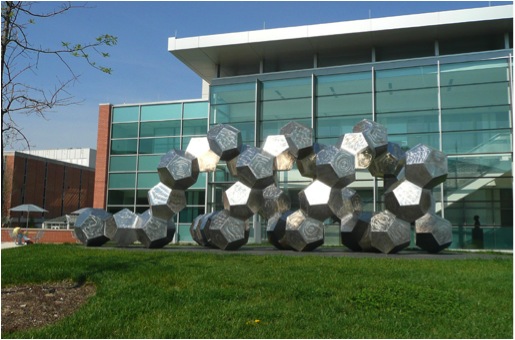
DOUBLE HELIX
c 2008, stainless steel, 3 m. hi. x 3m d. x 8 m. long. Ohio Arts Council Public Art Project, Diggs Life Science Lab., Wright State University, Datyon, OH
PARADIGM is also mathematical. Explain this work within a mathematical context.
PARADIGM is the sculptural expression of the DNA molecular structure, the double helix being the notable feature—here indicated by the spiralling pattern of the tube forms emanating from the body of the sculpture. The other important meaning of the sculpture is that it is the “axis mundi”—world axis, the metaphorical axis around which the world turns, the “still point of the turning world”, which is Brisbane during Expo.
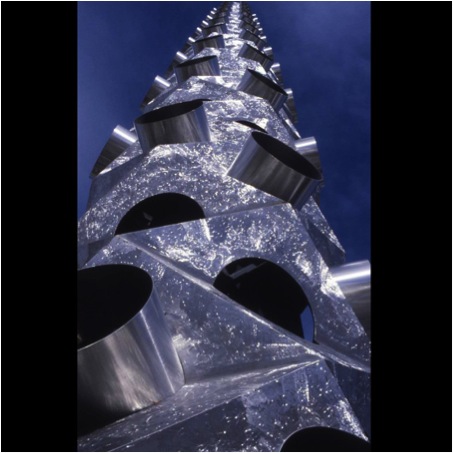
PARADIGM Detail
A paradigm is a pattern, example, or model, for example, of a particular world view during a certain time period. In my vision, the oscillating/spiralling aspect of this sculpture represents the changing, flowing, cycling of various aspects of the world along the continuum of existence. There is a pattern to events on the macro-cosmic perspective, more difficult of vision on the micro-cosmic level. On a rather micro-cosmic level the monocoque structural form and pattern of the sculpture is very reminiscent indeed of a “cholla” cactus “skeleton” from the Arizona desert, where I lived for a year. Even though it is a very geometric form it is nevertheless a very organic form in its essence.
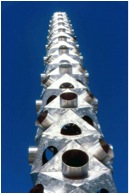
Speaking of skeletons, another reference that PARADIGM indicates is that of the vertebral column, which, while practicing Tai Chi or other martial arts, must always be very straight so that the energy may flow freely. Thus PARADIGM is a “vertebral column” between the earth and heaven thru which the energy of the universe flows. I think of PARADIGM as representing another aspect of existence—that each segment represents the conscious awareness of each present moment of being on the continuum of the progression of time, extending up into infinite space and time. The segments are designed with both yin and yang aspects to their form — the protruding cylinders and the round openings to the interior. This later aspect leads to yet another realm of meaning, inspired by the ancient Neolithic Chinese jade ritual objects called a “cong” or “ts’ung tube”, symbols of the unity of heaven and earth. They are generally square forms, often segmented horizontally, with a round, tubular space drilled through the entire stone: the square representing earth, the round space heaven. These are wonderfully intriguing and archetypal artifacts.
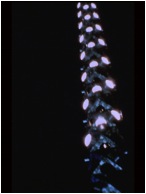
PARADIGM is 100 feet high by 8 feet diameter and about 42,000 #’s in weight. It is constructed of type 304 stainless steel—the body of the piece is built with 5/16” thick plate and the tubes are 1/8”. The interior structural elements are all of mild steel, painted with a heavy coat of PFI PF300 Savinite epoxy primer, a high-zinc paint developed for Rockwell International airplanes. The sculpture is built in 7 sections which are bolted together: I believe they are numbered in sequence, which is important due to the structural specs on each successive unit. It was engineered for 110 mph as requested by Expo 88. It has been in storage since Expo, for most of the time under a bridge nearby the river in Brisbane. It was moved to an interior space in advance of my arrival in Brisbane, in 2014, to inspect it and to further the reinstallation of PARADIGM in Brisbane. This is an ongoing challenge. Its companion Expo sculpture, MORNING STAR II, a 15 foot diameter mirror polished stainless steel geometric “diamond” or “star”, was after Expo reinstalled in the Brisbane Botanical Gardens close by the Parliament Gate. A sectional stainless steel maquette of PARADIGM has been offered to the Queensland State Library and was accepted, but awaits shipping. I have been lobbying anyone in government and otherwise regarding its reinstallation since the end of expo, most often the Lord Mayor. The current Lord Mayor has indicated his support for the reinstallation, but discusses the need for a suitable context and funding. As a result of not altogether proper storage, it now will require a bit of maintenance.
A wonderful gentleman in Brisbane, who has become a good friend, Mr. Peter Rasey, has been very energetic in promoting the reinstallation of PARADIGM. He is a committee member of the Lord Mayor’s Parks Advisory board and an advisor to the Lord Mayor and others, on special interests regarding tourist projects for Brisbane and the G20. So the fate of a powerful, meaningful, beautiful, landmark sculpture the equal of any other one cares to stand next to it, is still at risk.
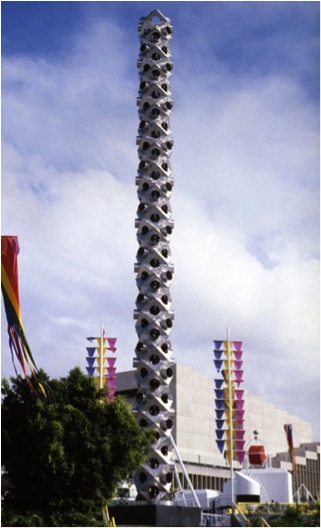
PARADIGM
c 1988, stainless steel & 66 airplane lights. 30 meters high x 2.6 m. dia.
Commissions for overseas must present logistic problems. Can you explain one or two of them?
For PARADIGM and MORNING STAR, I had to pre plan their construction taking into consideration the size limit for over—road transport, railroad and sea transport and the size of the steel land—sea shipping containers. MORNING STAR had to have a wooden crate built around it once it was about 80 % complete, not over 12 feet high, so it could go as one unit. PARADIGM had to be designed into 7 sections, so that they could all fit within the shipping container, both length–wise and width—wise. Since it would be constructed in seven sections, over a five month period and had to be constructed horizontally, it was never fully assembled prior to its Expo installation—it stood as straight as an arrow! The shipping had to be coordinated thru a state—side shipping agent and in cooperation with Expo. Once on site, I worked with two New Zealanders to complete MORNING STAR.
Another logistic experience was the commission, thru an architect in Hong Kong, for three large scale sculptures for a project in Jakarta in 1992. Once I had the sculptures completed, in order to ensure payment to me, and for the client to be assured that what they were paying for was indeed three sculptures, I had to have an SGF inspector, as part of the VCS (voluntary control system) come and inspect the sculptures at the fabrication facility, as to their voracity as sculptures conforming to what was ordered by the client in Jakarta. Once that was satisfactorily completed, arrangements were made with the shipping broker to truck the three large crates to the port for sea shipping. Upon their arrival in Jakarta, and damage to one of the sculptures, I spent a couple of weeks on site overseeing repairs of the sculpture and construction of the foundations, along with a stout case of Lord Ganesh’s revenge.
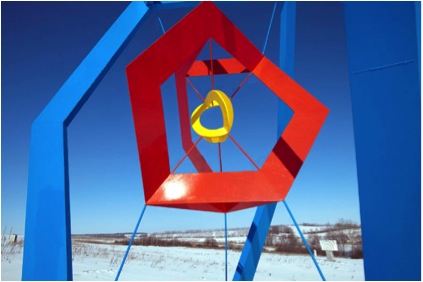
EIDOLA II
c 1992, mirror polished stainless steel, 4 meters high. Mulia Tower, Jakarta
Atrium sculptures must need different design techniques. Discuss one of your atrium pieces and the importance of the positioning in relation to the viewers.
The atrium installation TS’UNG MUSIC was designed for the four story atrium of the Emery Northlake office building just north of Cincinnati. The distinguishing characteristics of the space were the three glass walls surrounding the atrium, with all their mullions and the fourth wall was elevator balconies. On the wall opposite it, were two floor—to–ceiling columns and the ceiling contained a square grid of 25 square skylights, 5 to a row. I was charged by the architect to design a sculpture to work with the given environment of the atrium, so on one hand I had the round columns, on another the windows with all their mullions—lots of horizontal lines and vertical as well. I began working with a rough cage concept and I had the column shape to think about as well. Serendipitously I happened upon an Asian Arts magazine and on the cover was a photo of the Neolithic jade “cong”, or “ts’ung tubes” from ancient China. The author, Lars Berglund, explained that the jade ritual objects represented the unity of heaven and earth: the square outer form being earth, yin, and the round space boring through the square from end to end, is heaven, yang. On the outside surfaces of the square form are often found some vertical motifs and many horizontal incisions. Upon seeing these jade objects, it immediately brought my cage and my column forms together, the latter inside the former. Additionally, the concept of the unity of heaven and earth seemed appropriate for a sculpture suspended in space within a building.
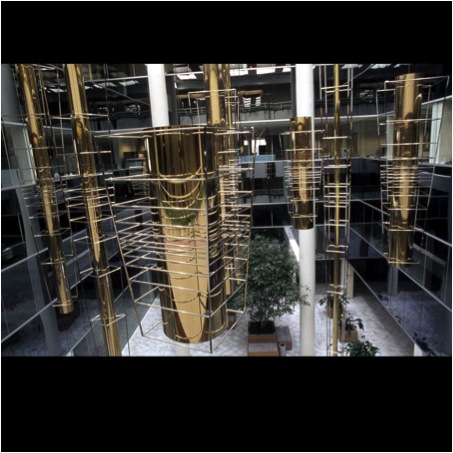
TS’UNG MUSIC
c 1986, photos JBH. Stainless steel & brass. 9 units, from 3’hi x 3’dia. To 27’hi. x 3” dia. Installed originally in Emery Industries/National Distillery Corp., Cincinnati, OH.
Once I had the basic form, what to do next? In looking at the space and how one is to suspend an atrium sculpture, one has to attach it to the ceiling. Given that there are 25 skylights, how to relate to them? What logic to work with? Perhaps in studying the ts’ung tubes, there I think was some mention of the magic square of alchemy and how that relates to the plan of the ts’ung tubes. There are 9 numbers in the square, from 1 to 9: even number in the corners, five in the centre and odd numbers on the sides. This set of numbers fits into the skylight grid of 25 in a diamond plan. So I then had 9 skylights from which to hang nine elements. (Far too many for the budget!) So if the number one position is the skylight for number one element, how to distinguish each from the other 9 elements? Thus 1 became 3 feet high by 3 feet diameter with each number progressing longer by 3 feet and each number progressing smaller in diameter by 3 inches, making number 9 the longest and thinnest. Then how to place them?
The cage design allowed me to utilize the Fibonacci numerical series in the spacing between the horizontal bars, but rather than start at one end, I started in the centre of each element, going both up and down, which allowed for them all to be placed within the space with the centre of each on the same plane, which was I think around the third floor more or less. They had to be high enough above the ground floor pedestrians yet not too high within the atrium. Thus each floor had a unique perspective on the installation.
New owners took over the property in 2008 and for some reason wanted a different “décor” so had the sculpture removed and destroyed, without contacting me or anything of that nature. This was my second Cincinnati atrium sculpture that was destroyed by the Taliban.
Your installations are not always metal. Explain you installation ‘Felt Hat Body Install‘ and relationship of the work to you wife and creative partner, Debbie Brush Henderson PhD?
My wife decided to go for a PhD. in costume history, with a focus on the history of the man’s hat, an area not previously studied. We travelled the country interviewing hat makers and sellers and visiting the few remaining felt hat making factories; in the UK and France as well. The steps of making felt hats are pretty much as they have been for a few hundred years, since “modern” machinery has been involved. The initial steps in forming the felt hat is a machine the blows the fur fibres along a tube, then into a space within which the air is circulated, carrying the fibres, round about a metal cone shape about 30 inches high or so, with holes in it so that the vacuum below it will pull in the circulating air carrying the fibres, which will then build up on the surface of the cone. This is done for a specified length of time to get the required thickness of fibres built up on the cone. It is then removed from the space, dipped in hot water, the felt hat body is then slipped off the cone and folded into a flat cone shape, rolled in a cloth dipped in cold water, beat about a bit, dipped in hot water, beat about a bit, for a few sequences, then moved on to the next steps. Down the line it has been pretty well “felted” together and also died a colour in many cases, so it is then fit over a machine that with steam will form the felt hat body into its first iteration in a hat shape. These are then inspected for potential imperfections and those that don’t pass are set aside and disposed of.
At a factory making such hats, I was provided with about a hundred of these felt hat bodies that did not pass inspection, with which to make a sculptural installation. While there are countless ways to assemble such shapes, I really like the cone shape and that, since it is the fundamental birth formation of the felt hat, and the hat is itself a sort of cone shape—the earliest hats were just that—it seemed to me a reasonable logic with which to assemble the felt hat bodies into a sculptural installation. The hats create a cone texture on the overall shape of the cone structure of their assembly. I chose the hanging cables in deference to the elliptical cable arches which Antonio Gaudi utilized in some of the construction of his great church, the Sagrada Familia.
Debbie chose a topic that we could do together, allowing us to travel widely in search of hats, hat makers, hat factories and the concomitant history. The project resulted in a museum exhibit, as I write this we go tomorrow to take down the 8th museum venue. Debbie also wrote four published books on the subject. We grew to be totally enthralled by the subject and its people and history. I even developed my own collection of hats to wear.
I would like to do more, but I also have a thing about making sculpture out of more permanent materials, like granite. While Debbie does not help with the making of the sculptures, she is my design partner.
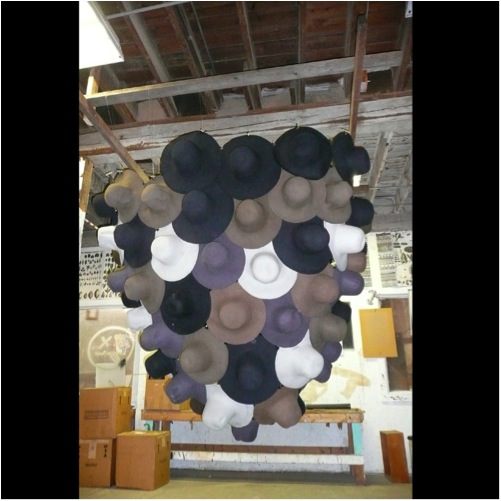
FELT HAT INSTALLATION
c 2007, 90 felt hat bodies and nylon lines, about 2 m. dia. X 3 m. hi.
You have work in 27 countries. How do you keep track of everything?
Sculptures are not sacrosanct. They get both taken good care of and not, sometimes vandalized, stolen, destroyed, pushed aside. Just the other day I went with this same friend to see one of my 1985 sculptures in the basement of the bldg. where it was originally installed, for a moved away corp. Thankfully it has been saved, but needs to have the clear lacquer removed, to be repolished and recoated.
Many of the overseas projects are just too far away to hope to deal with, and pertinent individuals that might have something to do with them are either long gone or out of touch. Occasionally, if I am lucky, I might hear from someone regarding a sculpture someplace. Of the two Expo sculptures, MORNING STAR is safe in the Botanical Gardens, though needs wash. PARADIGM, while now in a more secure and weather resistant storage facility rather than under a bridge, is still at risk. The Lord Mayor of Brisbane has indicated his interest in seeing it reinstalled, but how it gets paid for and what context within which to place it has yet to be determined. I have lobbied everyone I could find in Queensland since Expo to get PARADIGM reinstalled. Even seeing it in a dark storage building, laying unassembled in its individual sections, it is still a powerful and impressive sculpture. A great loss to the community not to be reaping the value of it installed.
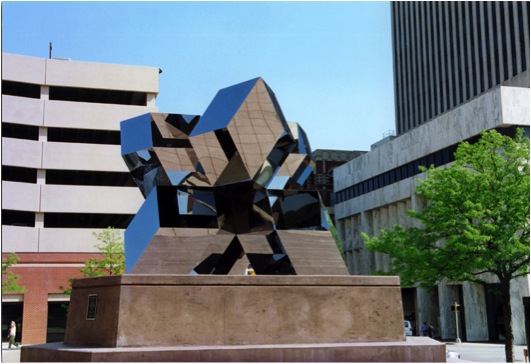
FIRE IN THE HOLE!
c1986, mirror polished stainless steel. 4 m. dia., Civic Centre Plaza, Omaha, NE
Do you feel that public art is dependent on the mood of the public or the financial directors?
The public is certainly involved, both as viewer and as tax payers and voters. Most projects tend to become accepted, but occasionally something is not and that can sometimes lead to its removal. The Tilted Arc wall sculpture in the courthouse park in New York City by Richard Serra being a notable example. The public is also part of the public art process as public art committee members, supporters, funders and the like.
They come and go, the type of art that is supported can also change. Today, as the use of computers increases in various aspects of design and construction, there seems to be quite a bit more works that are very much computer derived.
As for the financial directors, one would have to define who they are: whether public art committee members, city officials, community philanthropists, federal government officials or whomever.
Take one of your sculptures that you feel has a strong emotional effect on the viewer and why you think it has?
Probably the most comments I have received back, since the sculpture is in my home town, is for TREE OF KNOWLEDGE. Several community members thought we ought to have one of my sculptures here in town, since the rest of the world was getting them, so they set about raising funds and setting up the project. Once the commensurate funds were available, I set about making the mock-up.
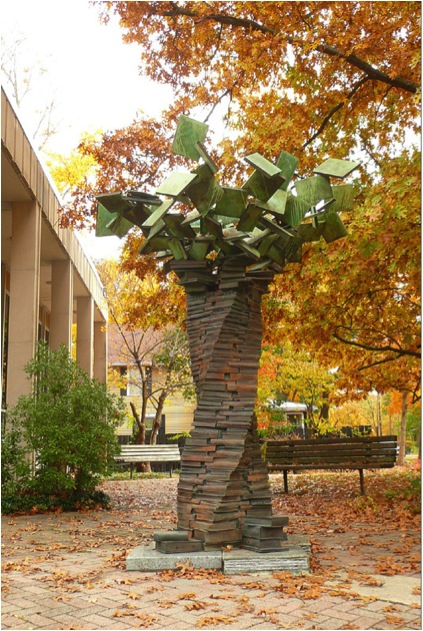
TREE OF KNOWLEDGE
c 1992, bronze, 3.6 m. hi. x 2.6 m. dia.
Public Library, Yellow Springs, OH. Plan grant from the Ohio Arts Council
In order for the project to develop, I worked up a proposal for them and for fundraising. In thinking about the town, we already have a “yellow spring” iron orange, which has been in use since the First Americans were here. The stone work around the spring was built up into a recognizable form in the early 50’s. In wondering how to represent the village in all its qualities, I got to thinking about the character and history of the village, I noted that we have had educational institutions here since the beginning, Antioch College was founded here in the 1850’s, there was also Antioch Publishing, Antioch Grade School, and history of educational experimentation, many writers, educators, artists, scientists and engineers, due to nearby Wright Patt AFB.
The common element of all these folks is books and book learning and the other characteristic about the village is its trees: we have the 1000 acre Glen Helen from the College, Bryan and Clifton State Parks, a serious Green Space program around the village and a dedicated Tree Committee, thus the tree became a likely contender for significant signifier. The first tree form I made, using book shapes, was just branches; it was too much like a dead tree. Then I was driving along in my car thinking about it and the tornado from the Wizard of Oz came to my mind’s eye and that provided the logic for constructing a tree of books. Since a tornado is a vortex, and one often sees large trees with a vortex structure to them, the vortex became the operative motif. I designed the trunk to be constructed of books in a helical plan and at the top, books continue spiralling out from the trunk to become the foliage, thus a moving tree form of books.
The vortex is found throughout nature, from the micro- to the macrocosm and is very indicative of life. The trunk of the tree is made from real books – real books were stacked up in the helical form then a latex mould made of it, then eventually cast in bronze. The foliage books were fabricated from sheet bronze, then welded into place. In the foliage area there is a “tree house” and also a “book plate” – Antioch Publishing used to print book—plates. On the trunk there is a “book worm”, with glasses, and various other items, like tape recorders and cassettes, some of the books were leather bound with great textures, I did not have a computer to include, so the tree is rather engaging for those willing to take time to explore. I just asked poet Amanda Williamsen to describe why the tree works so well.
“The books appear to take flight like birds: it is a celebration of books that come alive from the ground up, that anyone, regardless of art education, can easily perceive: it shows that learning is not static but growing: the roots of the tree – books which cover the actual hold down bolts – are not stodgy: the tree has motion in all its parts.”
What more can I say………..
Space. The space that a work will fit into must have a huge influence on the work you produce. Can you expand on this?
Some of my earliest works were found tree constructions in the nearby Glen Helen forest – form and space. Of course my early small scale sculptures were/are more about space and form as sculptures, often enough implied expansion beyond the confines of their material forms. As I grew into making large scale sculptures and finding ways to get them funded, that meant working in a wide variety of architectural, environmental and cultural situations. This in turn meant the question of how to integrate the sculpture into that particular project context. How to relate the sculpture to the forms, spaces, colours, textures, uses of the spaces, both interior, exterior and surface, and the broader cultural contexture. Such spaces can be a wall surface, atrium space, interior or exterior ground surface, natural setting, and street scape, each one of which requires different relationships to gravity and to affixing the work to whichever surface will be doing the support work. I am always working with gravity, whether consciously or not, secondly, structure, which is basically about gravity in any case, to the functional situation, the material with which to make the work, relative to all of the above, or some other aspect altogether. I think all of the above pretty much holds true whether you are working with stone, steel, lights, fabric, glass, water, plants, whatever. I have particularly enjoyed the challenges of creating sculptures that relate to many different spaces.
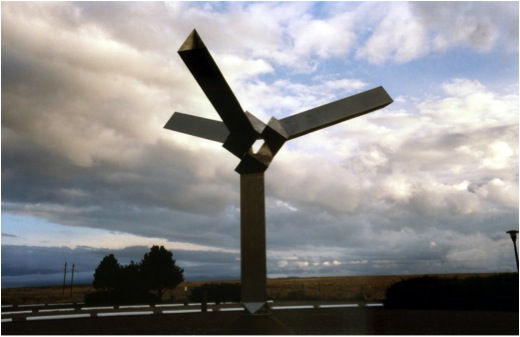
SHIVA : SHIWANA
c 1980, stainless steel, 5 meters dia., HQ of the National Radio Astronomy Observatory – Very Large Array, on the Plains of San Augustine, west of Socorro, NM.
One project I particularly enjoyed was for the National Radio Astronomy Observatory – Very Large Array, west of Socorro, NM. Given that it is what it is and listening to outer space, I wanted to include outer space in my sculpture, as well as the location on the ground. The telescopes are moved around on three rail road tracks, in a Y configuration. The telescopes are listening to objects in outer space, many of which are more or less “round” or symmetrical, as are a number of manmade objects orbiting the earth. Thus I came to the tetrahedral structure as one that could, first, reflect the Y configuration of the site rail tracks that could represent “spherical” bodies orbiting earth and also the celestial orbs filling outer space which the telescopes were listening to. My sculpture, SHIVA : SHIWANA, is fairly liner in format, which allows the three outstretched “wings” to reach into outer space. Though standing on one leg, like Shiva, it is totally symmetrical, it could easily be one of those objects floating freely in space. Within the ends of the wings, are shapes that utilized on buoy radar reflectors, which reflect the radar signal back to the sender of the signal, the sculpture is a listener to outer space just like the telescopes.
The name Shiwana, comes from the local Native American Tewa tribe, if I recall correctly, which is used to designate a healer that has received his powers from being struck by lightning. We have references to space both ancient and modern.
Discuss your thoughts of the importance of public art in public spaces? What would you like the public to gain form the experience?
Given the history of art and that it has been so much a part of virtually every culture since recorded time, within their public aspects as well as more private, it is pretty self-evident that it plays an important role in every society. It has even been used for negative ends in some cases due to its importance. For me, there is no question, there are always nae sayers and the Taliban who will blow up Buddas and destroy my atrium sculptures and such, and politicians that want to cut funding to the arts, all the studies show the importance of the arts not just to the cultural and social life of society, but to the economic prosperity of society as well. Almost every country round the world today has a sculpture symposia, as just one small example, the results of which contribute to the local communities where they take place.
When I started creating public sculpture in the 70’s in the States, you could count the number of public art programs on two hands – today there are hundreds. Another example is China – in the 70’s they were still doing social realist worker art yet today there are many artists creating wonderful art for public places throughout the country, such as the spectacular works of Ai Wei Wei. Having such a dragon to confront has given him the opportunity to probe the depths and rise to the challenge. He is their Michelangelo.
The public, if they desire, has everything to gain from having works of art within their communities. This has all been written about countless times before and no doubt better than I can do, so I will not labour the subject.
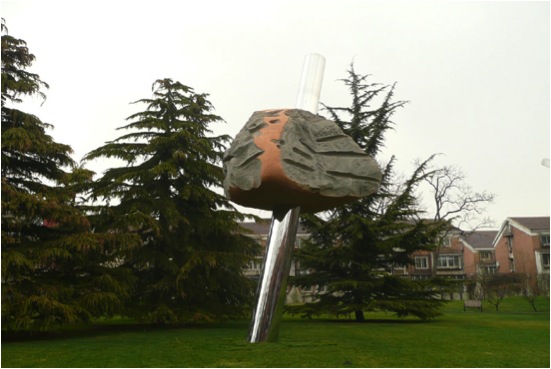
CLOUD & RAIN
c 2010, stainless steel and stone, 5 m. hi. x 2m. x 4m.Commissioned for the 30th Anniversary of détente between China and the USA. Installed in the Wanshou Park, Xuanwu dist., Beijing, China.
Do you feel that governments are giving the right patronage to the arts?
Patronage in the States has improved, over the years, not without plenty of hard work on the part of the supporters of the arts. Of course there could be more and broader support. Seeing today hundreds of public art programs across the country, supporting all the arts, and how supportive the public is of the various arts, I believe that there is ongoing improvement in this country. Though two local arts museums are having financial difficulties due to changes in the economy nationally and locally. The number of public art projects that I see and learn about in many different countries is very reassuring. I have been to 27 different countries to create sculpture in a wide variety of public settings, so I am very positive about the state of public art round the world. That is not to say that there are a good many countries that could do a lot more to support the arts, but even some of those that are hard pressed do provide some support. Each place, each country, is unique in this regard. I think the overall trajectory is positive.
Contact Details:
Website:http://www.hudsonsculpture.com
Email: jon@hudsonsculpture.com
Jon Barlow Hudson, Ohio, USA
Interview by Deborah Blakeley, September 2014
Think a colleague or friend could benefit from this interview?
Knowledge is one of the biggest assets in any business. So why not forward this on to your friends and colleagues so they too can start taking advantage of the insightful information the artist has given?
Other artists you may be interested in:


